Menu


You’ve probably been told to steer clear of poisonous wild mushrooms because of the belief that they’re so often dangerous. But the reality is there are several types of edible mushroom varieties. And, very often, they’re not just edible. Many edible mushrooms are also packed full of nutrients and contain several health benefits.
There are two types of edible wild mushrooms: culinary and functional.
Culinary mushrooms are nutritious and can be cooked in a variety of ways.
On the other hand, functional mushrooms may or may not be suitable for cooking, depending on their hardy texture. Some are just too leathery or woody to eat. These mushrooms do, however, contain healthful biologically active compounds which, when made into an extract, can help:
There are also unique wild mushrooms that are BOTH tasty AND contain functional properties.
With a growing interest in holistic nutrition, more people are turning to superfoods like health-promoting mushrooms to boost their immunity and health. With this in mind, you’ll learn about:
Wild culinary mushrooms are a category of edible mushrooms that you can either cook or take in supplement form.
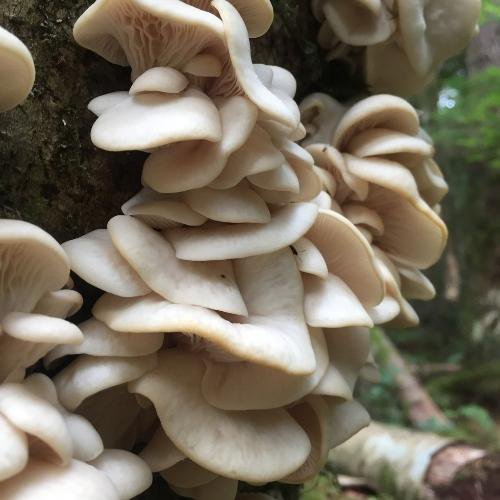
The oyster mushroom, also called the tree oyster mushroom, is scientifically categorized as Pleurotus sp. Oyster mushrooms are said to have a similar taste to seafood. They’re distinguished by their meaty texture, funnel-shaped cap, whitish-yellow gills, and white flesh.
Oyster mushrooms should not be mistaken for their poisonous wild mushroom look-alikes. Poisonous mushrooms that are often mistaken for oyster mushrooms include:
The table below tells you how to distinguish between a true oyster mushroom and a look-alike.
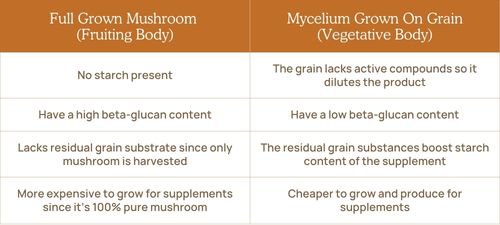
Where does this mushroom grow?
Oyster mushrooms grow in forests around the world. You can specifically find them growing on hardwood trees, such as dead or dying oak trees.
They grow all year round in warmer climates, as well as during the spring and fall in the Northern USA.
What benefits and special qualities do oyster mushrooms have?
Oyster mushrooms can help support the health of your cardiovascular system by enhancing circulation and maintaining blood pressure already within a normal range.
These mushrooms are rich in beta-glucans which show an apparent ability to support a healthy inflammation response and balance your body’s immune response [1].
Oyster mushrooms are also known to promote healthy blood sugar levels. A study involving 30 patients with type 2 diabetes who ate a minimum of 150 gms of cooked oyster mushrooms daily for seven days showed a reduction in blood sugar levels of up to 23% [2].
Oyster mushrooms have also shown great promise in mushroom foraging studies for mycoremediation—the process where mushrooms are used to break down and absorb toxic waste.
In nature, fungi and wild mushrooms, together with their mycelium-based networks (the “root” systems), are the reason our forests consistently regenerate without human interference. They break down waste into non-harmful and even useful materials [10].
Oyster mushrooms are no exception, and now we’re starting to find that they have the ability to break down much more. For instance, they’ve been found to have the ability to eliminate contaminants from both soil and water.
A Chicago-based lab study found that oyster mushroom mycelia were effective at removing E.Coli in water from the Chicago River.
The findings from this study prompted habitat restoration projects to start employing techniques such as planting oyster mushroom mycelia in burlap sacks and placing them in E. coli-infested waters to eliminate the contaminants [11].
In another study, researchers used oyster mushrooms to break down oxo-biodegradable plastic—the material commonly used in manufacturing shopping bags. In this instance, the mushrooms showed their mycoremediation capabilities within 45 days.
They were even able to degrade the synthetic dye in the plastic bags. Remember, synthetic dyes are a major environmental pollutant. Oyster mushrooms were found to be the most effective mushroom species for degrading the dye [12].
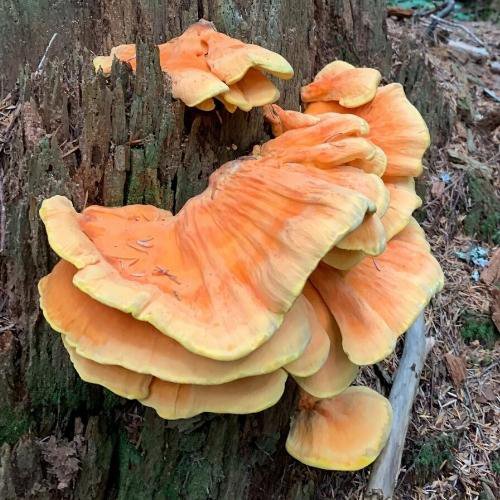
Also known as chicken-of-the-woods or chicken mushroom, it’s a sulfur polypore—a species of bracket fungi named for its bright orange or sulfur-yellow color and shelf-like structure that grows on trees. It is said to taste like lemon-flavored chicken.
Where does the sulfur shelf mushroom grow?
This bracket fungus grows on dead or living hardwood trees, such as oak, hemlock, and cherry trees. It grows from spring through fall and is primarily found in Northern America, Canada, and Europe.
What benefits and special qualities does this mushroom have?
Sulfur shelf mushrooms contain plant compounds which include, cinnamic acid, polysaccharides, and eburicoic acid.
A study conducted on mice showed that eburicoic acid could inhibit abnormal cell growth, promote a healthy inflammation response, and help maintain digestive health [3].
This mushroom is also rich in antioxidants, carbohydrates, proteins, organic acids, and bioactive compounds, which can help balance your body’s immune response and overall wells [4].
In addition to oyster mushrooms and chicken-of-the-woods, there’s a wide variety of wild culinary mushrooms you should also consider.
Mushrooms like lobster mushrooms, porcini mushrooms, morel mushrooms, hedgehog mushrooms, and even black trumpet mushrooms diversify your diet. These are highly sought-after by mushroom foragers for their nutrition-dense profiles and delectable flavors.
You can join mushroom hunters who regularly search for treasured golden chanterelle mushrooms to savor their earthy taste!
Watch the video below to follow along with Real Mushrooms’ Chief Funguy, Skye Chilton, as he forages for chanterelle mushrooms:
Functional mushrooms, though inedible due to their bitter taste, still provide health benefits useful for the body. These mushrooms are consumed as supplements in powder or capsule form. Examples include turkey tail mushroom and lion’s mane mushroom.
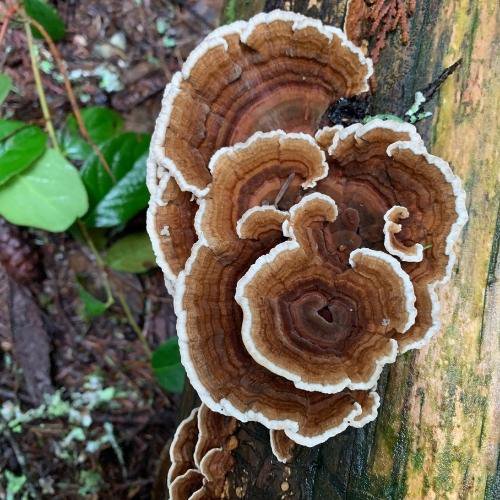
As the name suggests, this type of mushroom resembles a turkey’s tail. It belongs to the polypore variety and comes in various shades of brown, gray, and black.
Polypores are a group of fungi that feed on wood and have large fruiting bodies with tubes or pores on their underside.
Where does this mushroom grow?
Turkey tail mushrooms are a common variety that grow all over the world and on almost every type of tree, whether living or dead.
What benefits and special qualities does the turkey tail mushroom have?
Rich in antioxidants, the turkey tail mushroom is best known for its immune-enhancing properties. Antioxidants help fight the impact of oxidation as a result of excessive free radicals, which could lead to chronic inflammation and cellular damage.
Excessive free radicals have also been linked to certain conditions, including abnormal cell growth and heart disorders. Eating foods rich in antioxidants counters the effect of these radicals [5].
One study showed that turkey tail is rich in flavonoids, a particular antioxidant that stimulates the release of protective compounds and also promotes a healthy inflammation response [6,7].
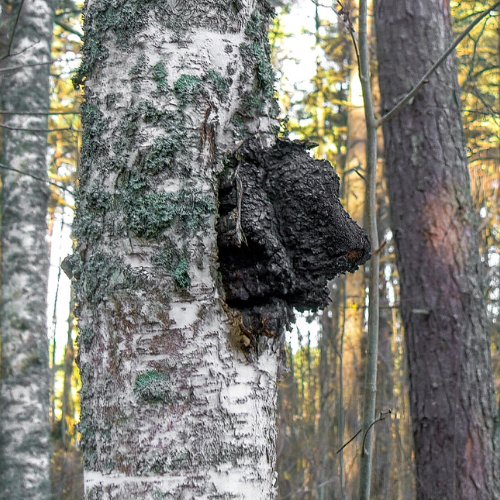
Chaga is a parasitic fungus that mostly grows on birch trees but can also be found on aspen, elm, and alder trees.
Where does this mushroom grow?
Although you can find this mushroom year-round, it thrives most in cold climate regions such as Russia, Alaska, Northern Europe, and Canada.
What benefits and special qualities does this mushroom have?
Chaga has been a part of traditional medicine for centuries in China, Korea, and Russia. They’re said to have a positive effect on the immune system by helping your body fight off free radicals.
Additionally, they also stimulate the production of white blood cells to help fight off harmful microorganisms. Studies conducted on animals showed that chaga mushrooms can help support immune function [8].
Another study showed slowed growth rates on malignant cells cultivated in a test tube when exposed to chaga mushroom. This further supports the idea that chaga mushrooms may be effective against malignant growths [9].
Turkey tail and chaga mushrooms by no means make up an exhaustive list of functional mushrooms. There are many different options comprising a wide selection of mushrooms, all of which have notable benefits—these include:

Some mushrooms straddle the line between functional and culinary. They claim the therapeutic benefits of functional mushrooms and the delectable qualities of culinary mushrooms—the best of both worlds.
Examples of these “hybrid” mushrooms include lion’s mane, shiitake, cordyceps, tremella, and maitake mushrooms.
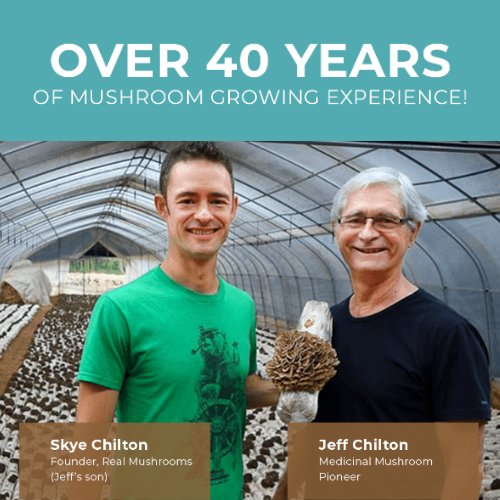
At Real Mushrooms, we take pride in providing our clients with the purest mushroom extracts. With over 40 years of experience in growing mushrooms, we’ve perfected our growing and extraction process, allowing us to obtain the purest organic extracts.
“I definitely have noticed an improvement in my memory, and ability to communicate productively and positively.” - JTS
Did you know that the bulk of mushroom supplements sold in North America are usually grain and filler products? A large percentage of mushroom supplements on the market contain myceliated grain with little to no mushrooms in them. This goes specifically against FDA policies.
We don’t claim to sell real mushrooms. We actually do sell you real mushrooms.
Our products are unique because we extract nutrients from the mushroom (fruiting body) and not the mycelium (“root system” that is the vegetative body).
Another added advantage? Real Mushroom products are safe for pets, too. Both you and your pets can enjoy the nutritional benefits of our mushroom supplements.
“Using this for my dog as additional support. She has multiple issues including low-grade Mast Cell, severe reflux, and a recent ortho surgery.” - Judi
Additionally, our products are available in both capsule and powder form and are gluten-free, vegan-friendly, and non-GMO.
1. Bashir, K. M., & Choi, J.-S. (2017). Clinical and physiological perspectives of β-glucans: The past, present, and future. International Journal of Molecular Sciences, 18(9), 1906. https://doi.org/10.3390/ijms18091906
2. Dicks, L., & Ellinger, S. (2020). Effect of the intake of oyster mushrooms (pleurotus ostreatus) on cardiometabolic parameters—a systematic review of clinical trials. Nutrients, 12(4), 1134. https://doi.org/10.3390/nu12041134
3. Wang, J., Sun, W., Luo, H., He, H., Deng, W., Zou, K., Liu, C., Song, J., & Huang, W. (2015). Protective effect of eburicoic acid of the chicken of the woods mushroom, laetiporus sulphureus (higher basidiomycetes), against gastric ulcers in mice. International Journal of Medicinal Mushrooms, 17(7), 619–626. https://doi.org/10.1615/intjmedmushrooms.v17.i7.20
4. Petrović, J., Stojković, D., Reis, F. S., Barros, L., Glamočlija, J., Ćirić, A., Ferreira, I. C., & Soković, M. (2014). Study on chemical, bioactive and food preserving properties of laetiporus sulphureus (bull.: Fr.) Murr. Food Funct., 5(7), 1441–1451. https://doi.org/10.1039/c4fo00113c
5. Prasad, S., Gupta, S. C., Pandey, M. K., Tyagi, A. K., & Deb, L. (2016). Oxidative stress and cancer: Advances and challenges. Oxidative Medicine and Cellular Longevity, 2016, 1–1. https://doi.org/10.1155/2016/5010423
6. Janjušević, L., Karaman, M., Šibul, F., Tommonaro, G., Iodice, C., Jakovljević, D., & Pejin, B. (2017). The lignicolous fungus trametes versicolor (L.) Lloyd (1920): A promising natural source of antiradical and ache inhibitory agents. Journal of Enzyme Inhibition and Medicinal Chemistry, 32(1), 355–362. https://doi.org/10.1080/14756366.2016.1252759
7. Pérez-Cano, F., & Castell, M. (2016). Flavonoids, inflammation and immune system. Nutrients, 8(10), 659. https://doi.org/10.3390/nu8100659
8. Ko, S.-kyung, Jin, M., & Pyo, M.-yun. (2011). Inonotus obliquus extracts suppress antigen-specific IGE production through the modulation of th1/th2 cytokines in ovalbumin-sensitized mice. Journal of Ethnopharmacology, 137(3), 1077–1082. https://doi.org/10.1016/j.jep.2011.07.024
9. Lee, S. H., Hwang, H. S., & Yun, J. W. (2009). Antitumor activity of water extract of a mushroom, inonotus obliquus, against HT-29 human colon cancer cells. Phytotherapy Research, 23(12), 1784–1789. https://doi.org/10.1002/ptr.2836
10. Purnomo A.S., Mori T., Putra S.R., Kondo R. Biotransformation of heptachlor and heptachlor epoxide by white-rot fungus Pleurotus ostreatus. Int Biodeterior Biodegrad. 2013;4:40–44. doi: 10.1016/j.ibiod.2013.02.013. doi:10.1016/j.ibiod.2013.02.013
11. Pini, A.K., Geddes, P. Fungi Are Capable of Mycoremediation of River Water Contaminated by E. coli. Water Air Soil Pollut 231, 83 (2020). https://doi.org/10.1007/s11270-020-4464-7
12. Da Luz J.M.R., Paes S.A., Nunes M.D., da Silva M.C.S., Kasuya M.C.M. Degradation of Oxo-Biodegradable Plastic by Pleurotus ostreatus. PLoS ONE. 2013;4(8):69386. doi: 10.1371/journal.pone.0069386. doi:10.1371/journal.pone.0069386.
Disclaimer: The information or products mentioned in this article are provided as information resources only, and are not to be used or relied on to diagnose, treat, cure, or prevent any disease. This information does not create any patient-doctor relationship, and should not be used as a substitute for professional diagnosis and treatment. The information is intended for health care professionals only. The statements made in this article have not been evaluated by the Food and Drug Administration. Any products mentioned are not intended to diagnose, treat, cure, or prevent any disease. The information in this article is intended for educational purposes. The information is not intended to replace medical advice offered by licensed medical physicians. Please consult your doctor or health practitioner for any medical advice.